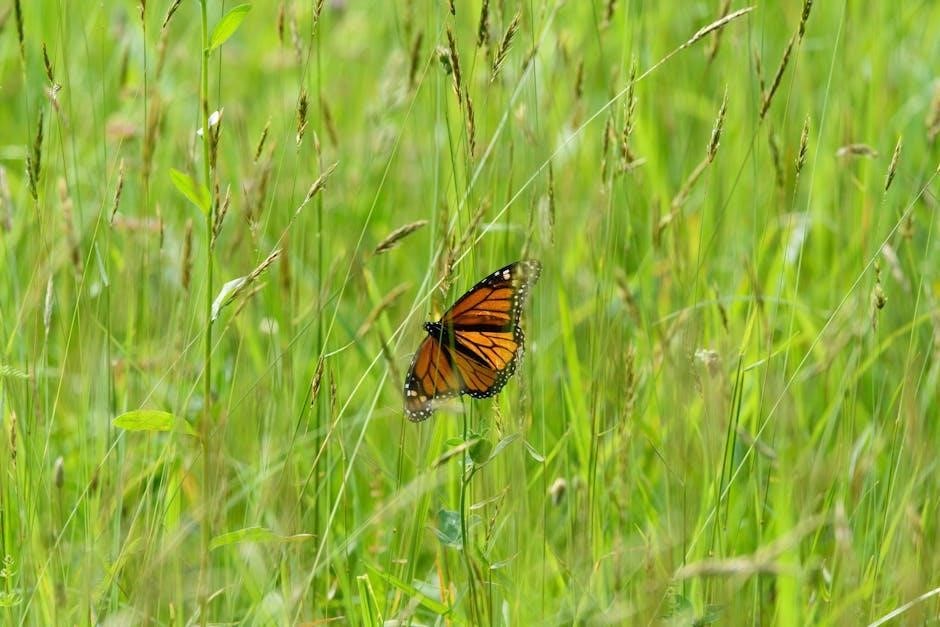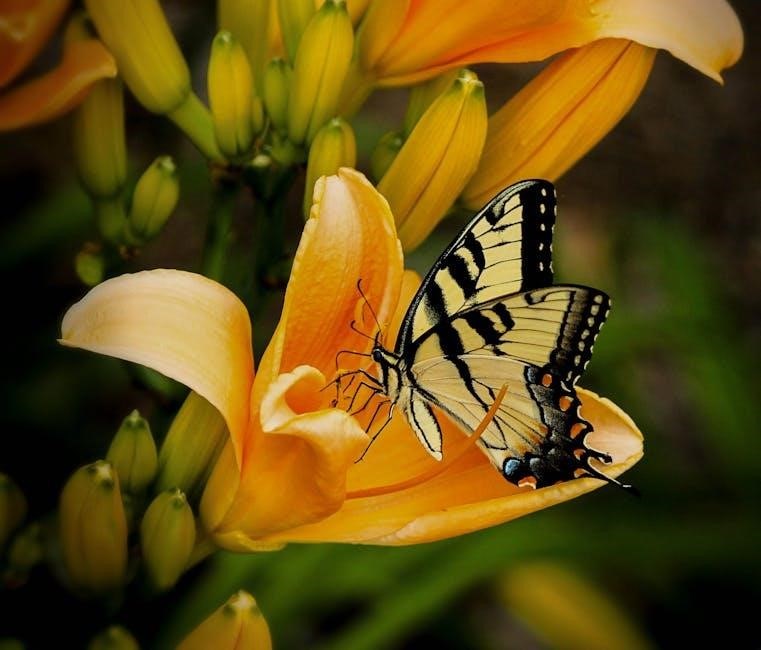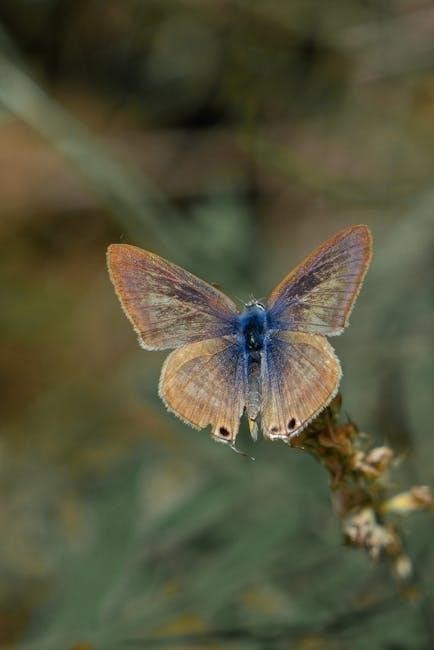
-
By:
- ida
- No comment
butterfly garden instructions
Planning Your Butterfly Garden
Start by selecting a sunny, sheltered spot that receives at least six hours of direct sunlight daily. Assess your garden’s purpose, whether for aesthetics or ecological support. Research local climate and soil conditions to choose suitable plants, prioritizing natives for better adaptation. Avoid pesticides to protect butterflies. Plan the layout to include water sources, host plants, and nectar-rich flowers, ensuring a welcoming habitat for all life stages. Consider overwintering habitats and windbreaks for protection. Create a diverse, colorful design with rocks and mud puddles to enhance attraction. Plan for seasonal challenges and maintain the garden regularly to ensure its success and sustainability.
1.1 Choosing the Right Location
Choosing the right location is crucial for creating a thriving butterfly garden. Butterflies are cold-blooded and need warmth, so select a spot that receives at least six hours of direct sunlight daily. Opt for a sheltered area to protect from strong winds, which can deter butterflies. Ensure the site has good drainage and avoid low-lying areas where water may pool. Consider soil fertility; butterflies often prefer areas with low soil fertility. Avoid locations near pesticide-treated zones to safeguard these delicate creatures. Proximity to a water source, like a shallow dish or puddle, is also beneficial. A well-chosen location sets the foundation for a welcoming butterfly habitat.
1.2 Determining the Purpose of Your Garden
Determining the purpose of your butterfly garden helps guide its design and plant selection. Are you aiming to attract specific butterfly species or create a general pollinator-friendly space? Consider whether you want a garden for aesthetic beauty, ecological support, or both. If focusing on aesthetics, prioritize colorful nectar plants. For ecological support, include host plants for caterpillars and ensure food availability year-round. Some gardens may also serve as educational spaces or wildlife sanctuaries. Clarifying your purpose ensures a tailored approach, making your garden more effective and enjoyable. This focus will help you make informed decisions throughout the planning and planting process.

1.3 Considering Local Climate and Soil Conditions
Understanding your local climate and soil conditions is crucial for creating a thriving butterfly garden. Assess your area’s temperature, rainfall, and sunlight patterns to choose plants adapted to these conditions. For instance, drought-resistant plants are ideal for dry climates, while moisture-loving plants suit wetter areas. Test your soil type and pH level to select plants that match these characteristics. Native plants are typically best suited to local conditions. Consider the life cycle of local butterfly species and provide seasonal food sources, especially if they remain year-round. Ensure adequate sunlight for warmth, as butterflies are cold-blooded. Incorporate water sources like shallow dishes or birdbaths with rocks. Avoid pesticides to protect butterflies and use natural pest control methods. Plan for seasonal challenges, such as providing overwintering habitats in harsh climates. Maintain your garden with regular care, including watering, pruning, and composting, to ensure a sustainable and welcoming environment for butterflies.

Selecting the Right Plants
Choose plants that provide nectar for adults and host plants for caterpillars. Opt for native species, as they attract local butterflies best. Include a variety of bloom times to ensure constant food sources. Select plants adapted to your climate and soil type for better growth. Incorporate colorful, fragrant flowers to maximize attraction. Consider drought-tolerant or moisture-loving plants based on your region. Mix annuals and perennials for seasonal diversity. Avoid invasive species to protect local ecosystems. Ensure plants cater to both adult and larval stages for a thriving butterfly population.
2.1 Nectar Plants for Adult Butterflies
Nectar plants are essential for adult butterflies, providing the energy they need to fly and reproduce. Choose flowers rich in nectar, such as Butterfly Bush, Lantana, and Milkweed. Opt for single-petaled blooms, as they are easier for butterflies to access. Incorporate a mix of annuals and perennials to ensure continuous blooming throughout the season. Native flowers like Coneflowers and Black-eyed Susans are highly attractive. Plant nectar sources in clusters to draw more butterflies. Avoid double-petaled varieties, as they hinder nectar access. Ensure plants thrive in your local climate and soil conditions. By planting a diverse array of nectar-rich flowers, you create a vibrant, energy-rich habitat for adult butterflies.
2.2 Host Plants for Caterpillars
Host plants are vital for caterpillars, providing the specific food they need to grow and develop. Different butterfly species rely on particular plants, such as Milkweed for Monarch caterpillars or Dill for Black Swallowtails. Research local species and plant their preferred hosts. Native plants are ideal, as they naturally support local butterfly populations. Host plants should be free of pesticides to ensure caterpillar survival. Plant them in areas where adult butterflies are likely to lay eggs, typically near nectar sources. A diverse selection of host plants attracts a wider variety of butterfly species, fostering a thriving ecosystem. Properly caring for these plants ensures healthy caterpillar development and successful butterfly life cycles.
2.3 Native Plants for Maximum Attraction
Native plants are essential for attracting butterflies, as they naturally attract local species. These plants have evolved alongside native butterflies, making them highly appealing for nectar and reproduction. Incorporating native flowers like Milkweed, Butterfly Bush, and Black-eyed Susans ensures a vibrant and welcoming environment. Native plants often require less maintenance, as they are adapted to local soil and climate conditions. They also provide the best chance of attracting a diverse range of butterfly species. Choose plants that bloom at different times to offer continuous nectar sources; Planting natives near host plants encourages butterflies to stay and lay eggs, creating a sustainable ecosystem. This approach supports local biodiversity and ensures a thriving butterfly garden. Native plants are a cornerstone of a successful butterfly-friendly habitat, promoting ecological balance and beauty simultaneously.
Maintaining Your Butterfly Garden
Maintain your butterfly garden by watering plants regularly, pruning dead blooms, and monitoring for pests without using pesticides. Ensure consistent sunlight and shelter for butterflies.
3.1 Providing a Water Source
Butterflies need water for drinking and to extract minerals, especially males. Use shallow dishes or birdbaths with fresh water and add rocks or twigs for landing. Change water regularly to prevent stagnation. Incorporate mud puddles, as they are essential for certain species to gather nutrients. Ensure water sources are in sunny spots to warm the water slightly, making it more appealing. Avoid using chemicals or pesticides in water features. Maintain cleanliness to prevent disease and attract more butterflies. A consistent water supply is crucial for their survival and activity in your garden.
3.2 Ensuring Proper Sunlight and Shelter
Butterflies thrive in sunny conditions, needing warmth to fly and feed. Choose a south-facing location with at least six hours of direct sunlight daily. Ensure shelter from strong winds by planting taller species or shrubs around the garden’s edges. Native trees or bushes provide natural protection and roosting sites. Avoid low-lying areas prone to frost pockets. Consider adding rocks or brush piles for additional shelter and warmth. Balance sunlight and shelter by placing taller plants on the north or west to block cold winds. Incorporate native plants adapted to local climate for low maintenance and biodiversity. Maintain a clean environment, removing debris to prevent predators. Ensure year-round shelter with evergreen plants for seasonal protection, enhancing the habitat’s sustainability and attractiveness for butterflies.
3.4 Avoiding Pesticides and Chemicals
Avoiding pesticides and chemicals is crucial for creating a butterfly-friendly garden. These substances can harm or kill butterflies and their caterpillars, disrupting the local ecosystem. Instead, adopt organic gardening practices to maintain a balanced environment. Introduce natural predators like ladybugs and lacewings to control pests. Use neem oil or insecticidal soap as safer alternatives for severe infestations. Remove weeds manually or use mulch to suppress their growth without chemicals. Keep the garden clean by removing dead plants and debris to prevent pest buildup. By eliminating synthetic chemicals, you create a safe habitat for butterflies and other pollinators, ensuring their survival and the garden’s biodiversity.
Designing the Garden Layout
Design a diverse, colorful layout with native plants, ensuring sunlight and shelter. Incorporate rocks, mud puddles, and water sources. Plant in drifts for visual appeal and accessibility, fostering a welcoming habitat for butterflies while maintaining aesthetic beauty and functionality.
4.1 Creating a Diverse and Colorful Design
A vibrant, diverse garden attracts a wide variety of butterfly species. Use a mix of annuals and perennials with varying bloom times to ensure constant color and nectar sources. Incorporate native plants, as they naturally attract local butterflies. Choose flowers of different heights and textures to add visual interest. Plant in drifts, grouping similar species together, which makes it easier for butterflies to navigate and feed. Consider adding shrubs or trees for shelter and overwintering habitats. A well-designed, colorful layout not only appeals to butterflies but also enhances your garden’s aesthetic appeal, creating a welcoming space for both wildlife and visitors.

4.2 Incorporating Rocks and Mud Puddles
Incorporate rocks and mud puddles to enhance your butterfly garden’s appeal. Rocks provide warmth for butterflies, as they often bask on them to regulate their body temperature. Place rocks in sunny, sheltered spots to create ideal resting areas. Mud puddles, known as “puddling stations,” are essential for male butterflies, as they extract minerals from the mud for mating. To create one, mix soil and water to form a shallow, muddy pool. Add organic matter like leaves or compost to enrich it. These features not only attract butterflies but also add unique, natural elements to your garden’s design, supporting their ecological needs and behaviors.

Troubleshooting Common Issues
Identify pests like aphids or caterpillars and use organic solutions. Monitor for diseases and replace infected plants. Address seasonal challenges by adjusting plant selections and habitats to ensure year-round vitality and attraction.
5.1 Managing Pests and Diseases
Monitor your butterfly garden regularly for pests like aphids, spider mites, or caterpillars. Use organic pest control methods, such as introducing natural predators or spraying soaps. Avoid pesticides, as they harm butterflies. Inspect plants for diseases like powdery mildew or root rot, and treat with fungicides if necessary. Remove infected plants to prevent spread. Encourage beneficial insects like ladybugs and lacewings to maintain a balanced ecosystem. Keep the garden clean, removing debris that may harbor pests. Hand-picking larger pests and using neem oil can also help. Regular maintenance ensures a healthy environment for butterflies to thrive without compromising their safety or the garden’s biodiversity.
5.2 Addressing Seasonal Challenges
Adapt your butterfly garden strategies to seasonal changes to ensure year-round support for these pollinators. In spring, focus on planting early-blooming flowers for emerging butterflies. Summer requires consistent water sources and shade to prevent overheating. Fall necessitates plants with late blooms to aid butterflies in building fat reserves for winter. Winter demands protection for overwintering habitats, such as leaving leaf litter intact. Avoid pesticides year-round to safeguard butterflies. Ensure continuous blooming by planting a variety of flowers that thrive in different seasons. Regularly inspect plants for damage and provide shelter from harsh weather. These efforts will help your garden remain a haven through all seasons.

Additional Tips for Success
Plant in drifts for better attraction, provide overwintering habitats, and create windbreaks for protection. These strategies enhance biodiversity and ensure a thriving butterfly sanctuary year-round.
6.1 Planting in Drifts for Better Attraction
Plant flowers in large groups or drifts to create a vibrant, visually appealing display. This clusters plants, making it easier for butterflies to locate nectar sources. Grouping similar plants by growth habits and soil needs ensures optimal care. Drifts of native plants attract local species, promoting biodiversity. Incorporate plants with varying bloom times to provide continuous flowers throughout the season. This technique mimics natural habitats, offering butterflies a consistent food supply. Drift planting also enhances pollination and creates a dynamic, ever-changing garden landscape that supports wildlife year-round.
6.2 Providing Overwintering Habitats
Creating overwintering habitats is essential for supporting butterflies during colder months. Many species rely on protected spots like leaf litter, shrubs, or hollow logs to survive winter. Incorporate native plants that provide shelter and insulation, such as tall grasses or shrubs with dense foliage. Avoid disturbing these areas during winter to ensure butterflies remain undisturbed. Consider adding brush piles or rock piles, which offer hiding places and protection from harsh weather; By providing these habitats, you create a safe space for butterflies to rest and emerge when spring arrives, ensuring their life cycle continues uninterrupted.
6.3 Creating a Windbreak for Butterfly Protection
Butterflies are sensitive to strong winds, which can hinder their ability to fly and feed. To protect them, create a windbreak using natural elements like shrubs, trees, or rock walls. Native plants with dense foliage are ideal, as they provide effective shelter while blending with the garden’s aesthetic. Place the windbreak on the windward side of the garden to deflect gusts without blocking sunlight, which butterflies need for warmth. Ensure the windbreak is low-growing to avoid casting shade. Regularly maintain the area to prevent pests from hiding in overgrown vegetation. This protective measure ensures butterflies can thrive in a safe and stable environment.